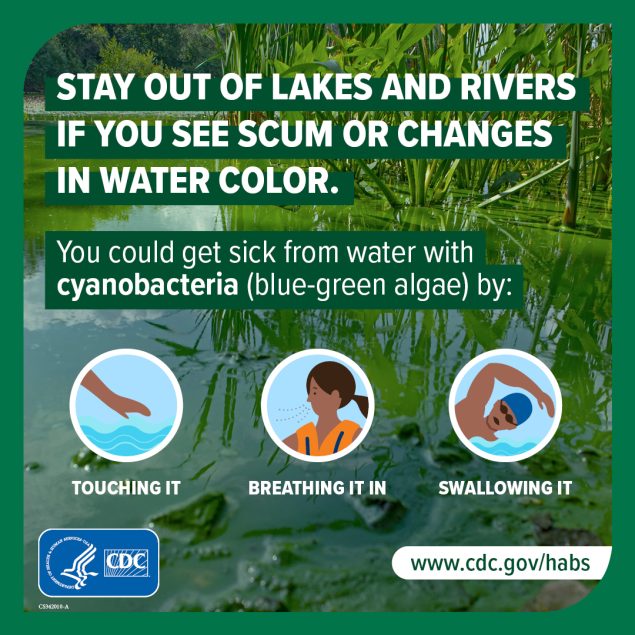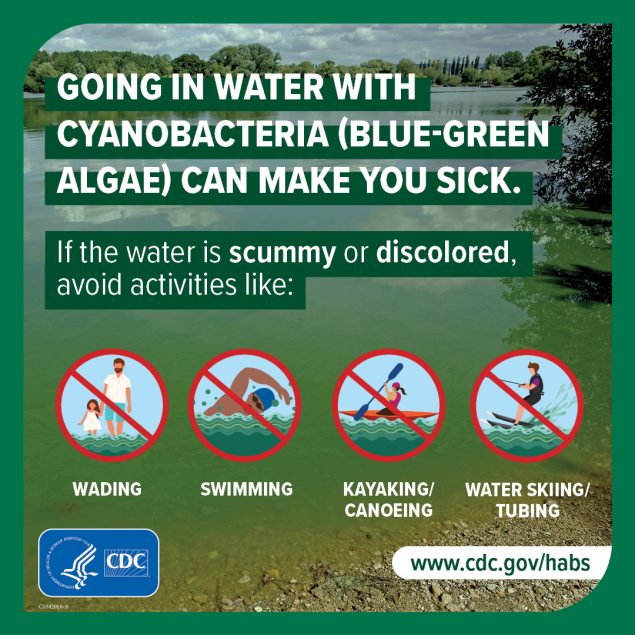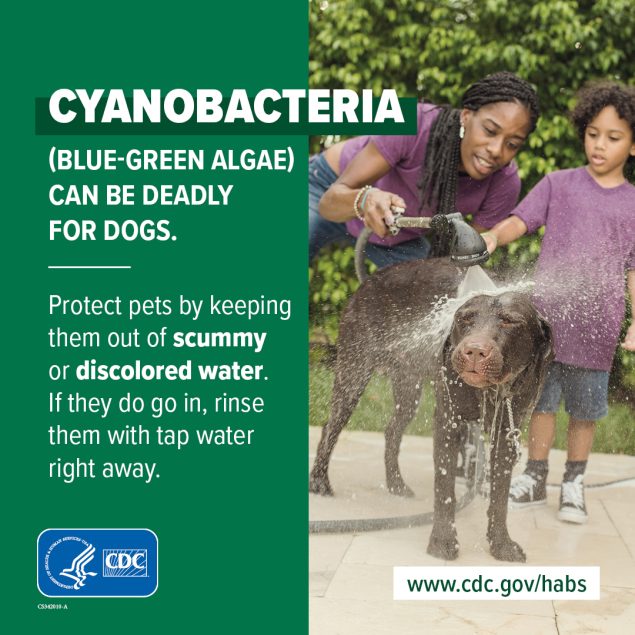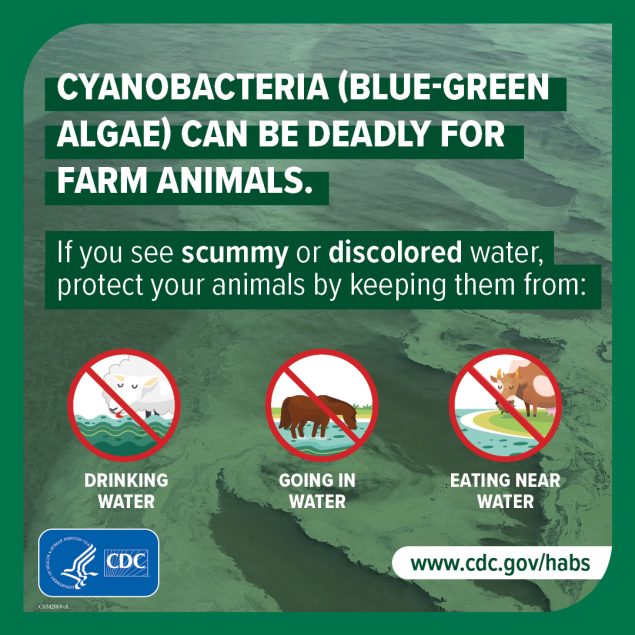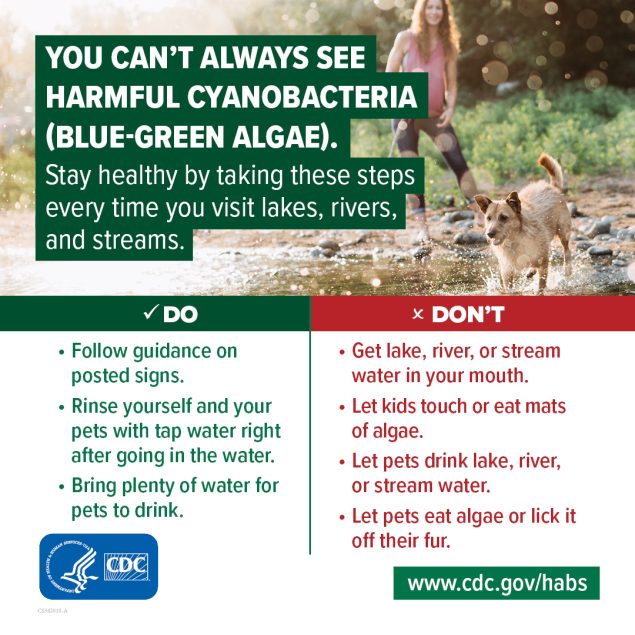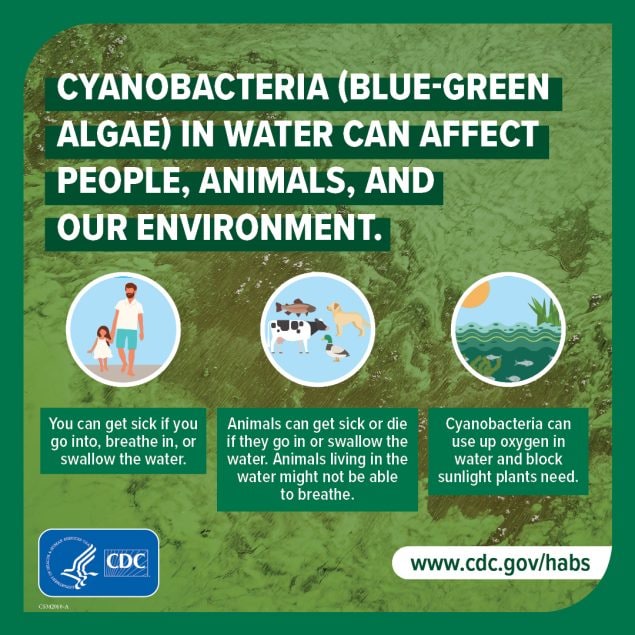Social Media Toolkit
Harmful Algae and Cyanobacteria Awareness
CDC has developed sample social media messages and graphics for health departments, environmental health professionals, and the public to use on their social media channels to increase awareness about harmful algae and cyanobacteria (sometimes called blue-green algae).
The messages focus on the following topics:
- Get the Facts About Harmful Algae and Cyanobacteria
- Learn the Signs of Illness
- Protect Your Pets and Livestock
- Understand the Environmental Connection
- Take Steps to Prevent Illness
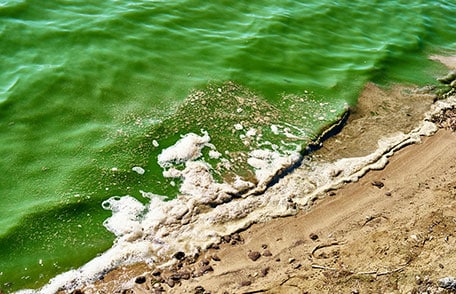
Interested in learning about harmful algae and cyanobacteria from CDC? Follow us on Twitter at @CDCEnvironment and @CDC_NCEZID.
Help spread the word about harmful algae and cyanobacteria by sharing the messages below on social media.
Get the Facts About Harmful Algae and Cyanobacteria
- Harmful algae and cyanobacteria can make toxins that hurt people, animals, and the environment. Learn what they are and how to avoid them. https://bit.ly/3zjDLe6
- Do you know how to spot a bloom of harmful algae or cyanobacteria? Blooms can look like foam or scum on the surface of water. They can also be different colors, like green, blue, red, or brown. Don’t go into water with a harmful bloom. Learn more: https://bit.ly/3zjDLe6
- Does the water look scummy or discolored, or smell like rotting plants? These could be signs of harmful algae or cyanobacteria, which can harm you and your pets. Learn more: https://bit.ly/3zjDLe6
- Blooms of harmful algae and cyanobacteria occur across the world. Harmful algae and cyanobacteria can grow in fresh water, saltwater, and brackish water (a mixture of fresh and salt water). Learn more: https://bit.ly/3wooAyN
Learn the Signs of Illness
- Toxins from harmful algae or cyanobacteria can make people sick if they swallow, touch, or breathe in droplets from contaminated water. Learn the common signs and symptoms: https://bit.ly/3gkNTuM
- Eating fish or shellfish from water with a harmful algal bloom can make you sick. Check for local advisories before fishing or collecting shellfish. Learn more: https://bit.ly/3cyxX6V
- Breathing in airborne droplets or mist that contain toxins from red tides in the Gulf of Mexico can cause your eyes to burn or make you cough and sneeze. Check for red tide advisories from your state or local government before visiting the ocean or coast. https://bit.ly/3cyxX6V
Protect Your Pets and Livestock
- Do not let your pets swim in, play in, or drink water that looks discolored or has foam or scum on the surface. These could be signs of harmful algae or cyanobacteria, which can be deadly for pets. Learn more: https://bit.ly/3gllTHj
- If your pet gets into scummy or discolored water, rinse them off with tap water right away and don’t let them lick their fur. Algal and cyanobacterial toxins could be in the water. Call a vet right away if your pet seems sick. More info: https://bit.ly/3gllTHj
- Do you own livestock, such as cows or sheep? Keep livestock away from scummy or discolored water. Water that contains cyanobacterial toxins can be deadly for animals. Learn more: https://bit.ly/3gllTHj
- Cyanobacteria (blue-green algae) can be deadly for dogs if they swallow contaminated water. When visiting lakes and streams, keep your pets safe by bringing plenty of water for them to drink and not letting them eat algae. More tips: https://bit.ly/2TUNTdk
Understand the Environmental Connection
- Did you know? Climate change can increase the growth of harmful algae and cyanobacteria in fresh, salt, and brackish water. It can make blooms occur more often and be more severe. Learn more: https://bit.ly/3wooAyN
- Harmful algae and cyanobacteria are a One Health issue that affects people, animals, and the environment. Learn more: https://bit.ly/3wooAyN
Take Steps to Prevent Illness
- Headed to the lake or beach this weekend? Look for swimming advisories and water quality notices online or near the water before visiting. https://bit.ly/3zjEwns
- Before swimming, boating, or fishing, learn tips to help you spot harmful algae and cyanobacteria (blue-green algae). Avoid getting sick by staying out of water with these signs: https://bit.ly/3gaBzhO
- When in doubt, stay out! You can’t tell for sure if an algal or cyanobacterial bloom is harmful just by looking at it. Protect yourself and your pets by not swimming in bodies of water that smell bad or look discolored. https://bit.ly/3gllTHj
- Check for and follow local shellfish and fish advisories before eating any fish or shellfish you collect yourself. Algal and cyanobacterial toxins in fish or shellfish have no taste or odor. https://bit.ly/3gllTHj
Use the social media graphics below on your social media channels, such as Facebook and Twitter. For more graphics, visit the graphics webpage.
You can use the materials below to educate your partners and the public about harmful algae and cyanobacteria. You can also order FREE printed materials from CDC-INFO On Demand.
- Animal Safety Alert Poster, also available in Spanish
- Cyanobacterial Blooms: Information for Healthcare Providers, also available in Spanish
- Cyanobacterial Blooms: Information for Pet Owners, also available in Spanish
- Cyanobacterial Blooms: Information for Veterinarians, also available in Spanish
